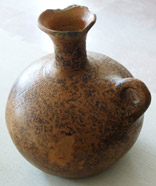The Village of Keren - Its Past and Future
“Let the politicians view all this in a political context. I’m a scientist and for me it has an archeological, historical and artistic value”, says archeologist Artak Gnuni.
On display in Stepanakert today are the results of some one and a half years of excavations carried out by Gnuni and geologist Gagik Khatchatryan at the tombstone plot in the village of Keren that is located in the Kashatagh region of Nagorno-Karabakh.
These artifacts include horned cups, large bowls, zoomorphic jugs and fragments of armour dating back to 12th -5th centuries B.C. There are also items dating back to a later period, from the 3rd -4th centuries A.D. that were also unearthed in Keren. With their discovery the matter of arriving at a set of comprehensive overall conclusions was somewhat complicated, but at the same time they added a new, interesting dimension to the dig site.
The village of Keren first became a focus of attention in 2003 when architect Stepan Nalbandyan came across some vessels and pieces of armour while visiting the area. These he gave to the geology museum in the town of Berdzor.
 |
 |
 |
In 2004 the expedition team of Artak Gnuni and Gagik Khatchatryan from Armenia’s Historical-Cultural Legacy Research Center set out for Keren.
“What we saw wasn’t all that eye-catching, says Artak Gnuni. Just a lot of dilapidated and razed to the ground tombstones.”
The burial plot was being destroyed by nature on the one hand and people on the other. Local springtime floods would first unearth the tombs. Afterwards people would come by and without understanding, or rather, fully comprehending the historical and archeological value of the unearthed items, would carry them away. As a result, many fragments whose on-site study could have shed light on a host of intriguing scientific questions, have all but disappeared.
“Our first objective was to study those tombs already in an endangered state, says Gnuni, in whose opinion their total destruction was not just a matter of weeks, but days. We told ourselves that at least we should study these tombs.”
The team visited Keren six times during a one and a half year period. What they eventually discovered was that the area wasn’t just one tomb site but an entire complex of gravestones that stretched from one bank of the Voghj River to the other. This area isn’t far from the city of Kapan in Armenia so it isn’t mere coincidence that a portion of the artifacts found there somewhat resemble items from the same period housed in the city’s geology museum.
 |
 |
 |
“We also uncovered the remains of two settlements that haven’t yet been studied. As to whether the burial sites date from the same period is an issue to be researched in the future”, notes Artak Gnuni.
The expedition team examined some 20-25 tombs in which mostly pottery was found. The main attraction of the Stepanakert exhibition is this figure of a man with outstretched arms (seen on the left). He’s wearing a belt. The dots by his hands signify bracelets, those on his forehead, a headband, and those on his throat, a necklace. The decorations on the neck, chest and waist are all solar patterns. The man is naked with the phallus portrayed. On the phallus is pictured the tree of life. In the one hand he holds a cup that, with certain unique features, very closely resembles the horn-shaped cups widely in use during the middle of the 1st millenium B.C.
“When we opened the tomb we saw this figurine that appeared to be embracing the two-cup vessel placed opposite him and touching the bull-like vessel with the free hand. Opposite the figurine were placed a number of cups and jugs”, the archeologist relates.
In his opinion this specific layout of items is unique and might prove quite helpful when it comes time to making certain conclusions. “ It may be that all this depicts the preparatory stage of a drinking or eating ceremony. It can’t be ruled out that in addition to reflecting a purely conventional activity, it also has a deeper symbolic significance that is linked to the ‘life-death-rebirth’ cycle.”
All this remains conjecture for now. The entire Keren burial complex needs to be comprehensively excavated in detail to reach any scientific conclusions since no one knows what the other tombs contain or how they might assist in arriving at a more correct interpretation of the articles already unearthed.
For this reason the site at Karen must be safeguarded from further destruction and plunder. It’s standard procedure throughout the world for such sites to be granted special protected status. Artak Gnuni is pleased with the assistance granted for their fieldwork and thinks that the Nagorno-Karabakh Ministry of Culture along with the Department for the Preservation of Cultural Monuments will soon begin to contemplate ways to protect the burial site. “ The bottom line for everything is money. But if we can’t obtain the funds or if we’re economical with what we have, tomorrow’s losses will be much greater”, concludes the archeologist, confident that the site hides many more mysteries to be solved.
After the exhibition closes the articles unearthed at Keren will find their final haven at the Stepanakert Geological Museum.
Translated by Hrant Gadarigian
 Videos
Videos Photos
Photos
Write a comment